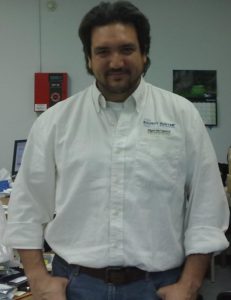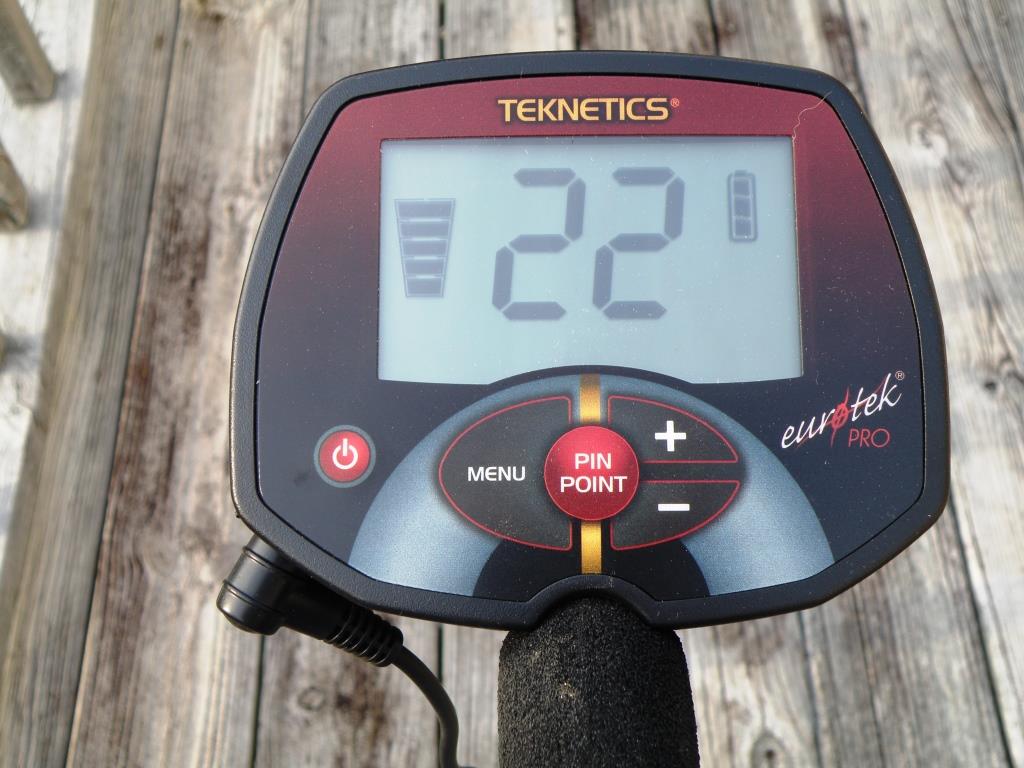 DS: Hi Mr. Saad! Thanks for taking the time to answer a few questions about the very unique F5! There is a lot of interest in the metal detecting hobby about this unusual detector… First of all, tell us about yourself…. How long have you been designing metal detectors?
DS: Hi Mr. Saad! Thanks for taking the time to answer a few questions about the very unique F5! There is a lot of interest in the metal detecting hobby about this unusual detector… First of all, tell us about yourself…. How long have you been designing metal detectors?
Jorge: Good day Mr. Ellington. It is a pleasure to have the opportunity of speaking with you. I first learned about the metal detector’s technology barely three years ago, when I was hired in First Texas Products and got under the expert lead of Dave Johnson and John Gardiner, who you know are two of the top leading engineers in the Industry. Before that I used to write firmware for other kind of products.
DS: What machines have you had a hand in designing?
Jorge: I was involved in the design of the Bounty Hunter Platinum and Gold; and the Fisher F5 machines.
DS: What’s it like working at First Texas? (The people you work with, the philosophy, atmosphere, etc.)
Jorge: FTP is unique in many aspects. We have a very friendly and open environment. Dave, John and Mark are great people to work around. We are quick with a joke and always on the mood to help each other. Our CEO is also a great guy to work for. We consider ourselves happy to be working here, and that adds a lot to our team. In addition the philosophy of FTP has always been geared towards overall customer experience and satisfaction; as a result here in the Engineering Department we keep open and in touch with as many people using our products as we can spare time for. To learn from their experiences and preferences is vital to develop the metal detectors they dream about – or at the very least get close. As close as physics will allow! We are lucky to enjoy a wonderful support and feedback from our customers and field testers via forum chats, email and phone calls. Those guys are an indispensable part of this team!
Read more of this great interview below!….
DS: Okay…now down to F5! While detectors from most companies seem to be moving more in the direction of membrane type buttons, (and the F5 does have a few too) the F5 has 4 knobs… why did you decide to utilize knobs?
Jorge: Dave was tired of cumbersome menu systems and wanted to come out with a menu-less environment that was easy to use. It would have knobs and buttons for each function without resembling a 747 cockpit too much, and it would be user-friendly. It was quite a challenge, but we finally came out with the right balance of knobs, buttons and information on the LCD to make the F5 what we intended.
DS: What are the unique features of the F5?
Jorge: Certainly the user interface is quite unique on the F5. No other detector in the market offers the richness of information the F5 provides at a glance, combined with such an easy control set. It is the detector anyone would love to have had to learn the tips and tricks of the serious hobbyist, all without having to concern themselves much with a machine’s tricks and… idiosyncrasies. The F5 is hot and lets you concentrate in what is really important. What the F5 is telling you is: Learn how to detect! You don’t have to learn how to operate me! That is a sweet machine, really. Now, do not let the easiness of the interface deceive you; the F5 is a serious detector. It has enough bite to be considered a fair gold prospector and be up there competing fiercely in its price range.
DS: How tough was it to get things “right” when designing something this different?
Jorge: It is always tough. First you have to keep your ear on the ground and figure out what is it that your customers desire the most (our Marketing and Customer Service departments are very good at that, thankfully). Then you come out with a wish list and start working on it. Unfortunately at the current state-of-the-art some of the features cancel each other, so you have to choose what are the best features you can put together that will work really good. Then you design over your spec fighting costs as hard as you can, so you can deliver a good product for the money. Finally the fun part: Lots of going back and forth replacing code, making changes to schematics, adding features, removing obsolete functions, optimizing resources, debugging, see what the field testers have to say and if they trash it all out, thank them for their hard work and start all over again. It has, however, its huge reward: When you finally put a finished product in a customer’s hands and they just can’t keep ‘em off… makes you only want to jump into your lab chair and engage with another project as soon as you can.
DS: What’s your favorite feature of the F5 and why?
Jorge: I absolutely love the almost non-existing learning curve of the F5. You can take a newbie out with it, explain what the controls are for and start detecting right on the spot – nothing complicated to learn or to know beforehand about the machine. You can focus on the fun stuff right away. You could almost ignore the manual to start using it! (I would not recommend that though – the manual has some great practical advice and detail you will not get no matter how much practice you have). I also really like the continuous phase readout. Gave us a bit of trouble and few headaches, but we finally got it right. Thank you Mr. Johnson.
DS: There’s a gain and threshold control knob side-by-side on the F5. What is the design intent for their relationship to each other?
Jorge: Well this is a tricky one, because it involves some trade secrets. I can tell you however that almost every other machine in the market has a combination of Gain and Threshold combined in a single “sensitivity” control of some sort. By breaking the sensitivity control into its factors the F5 response can be controlled to match the exigencies of a wider variety of field conditions: Noise, soil types and compositions, EMI and other interferences.
DS: I’ve heard you’ve been lead Designer on the F5… is that true?
Jorge: The F5 project was assigned to me. I coordinated the firmware writing efforts and wrote most of the software for it. Mr. Johnson however did all the hardware design. I tried to help (and one or two minor ideas made it to the hardware design too), but then, how do you help Dave to design a metal detector??
DS: Who else had a ‘hand’ in the design of the F5?
Jorge: Lots of talent were pulled into this project. John Gardiner helped with some hard routines, particularly on the Target ID engine. Dave Johnson took care of the hardware design and revisions; Mark Krieger wrote a crucial piece of firmware and also supervised the final layout stages. Marvin Jones had an expert hand in the layout process too. The mechanical package (including the shape and size of the LCD, the position of the knobs and buttons, the colors and the materials, the mechanicals of the tubes and shafts – and everything else) was the result of a coordinated effort between Engineering, Production and Marketing. While the F5 is my project, I see it as the result of a successfully coordinated effort of many other people.
DS: It appears the F5 shares the housing with the F4 and F2. Are there any other similarities?
Jorge: No. The F2 and the F4 share the same basic platform, but not the F5. The F5 is coming from an entirely new platform and its software is new as well, though some of the concepts were borrowed from the F70’s software.
DS: Could knob driven interfaces be a future trend for Fisher
Jorge: I personally fell in love with those knobs, but that is for the customers to say, really. Now they know we can do nice, sweet, knobby interfaces. How would they like to see more of that? We will see – we are listening. In the meantime, we are working on some other interesting propositions, some of which include knobs. I think you will like what is coming.
DS: The audio characteristics are unique on the F5 compared to other Fisher designs… was this difficult?
Jorge: It was more a result of the platform the F5 came from. The difficult part was to convey as much information as possible about the target without getting noisy. That is always a challenge on new designs.
DS: Are there plans for other coil options for the F5?
Jorge: Yes! We are looking forward having some accessory coils for the F5 and other machines. We will get there soon.
DS: All the new Fisher machines have incredible battery life! Is the F5 also super efficient?
Jorge: You can expect more than forty hours on a fresh pair of batteries with the F5.
DS: How in the heck are you guys at Fisher able to crank out so many innovative metal detectors at the pace you’ve set?
Jorge: Each of us have a hammock beneath the workbench, drink about four gallons of espresso a week, do not take vacations and see wives and relatives twice a year when they let us off the lab. Seriously, the creative muscle of this team is quite impressive. I think you will like what we have on the burner for the next season.
DS: What’s in store for Fisher Fans in the future? (if you can give us a sneak peek!)
Jorge: Well, Dave has been walking around mumbling funny numbers for more than two weeks now. Our lead engineer has been working on some of the most recent wants of our customers. I can tell you, Fisher is up to the bat again and has its major players on the move. You will not be disappointed.
DS: Thanks for taking the time to answer these questions!
Jorge: Quite the contrary Sr., thank you for being a channel of communication and for all the time and effort you put on this hobby.



